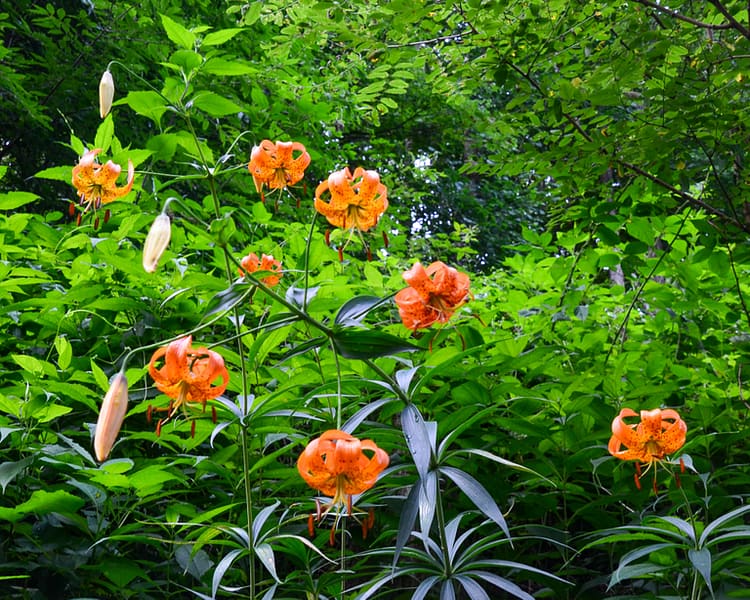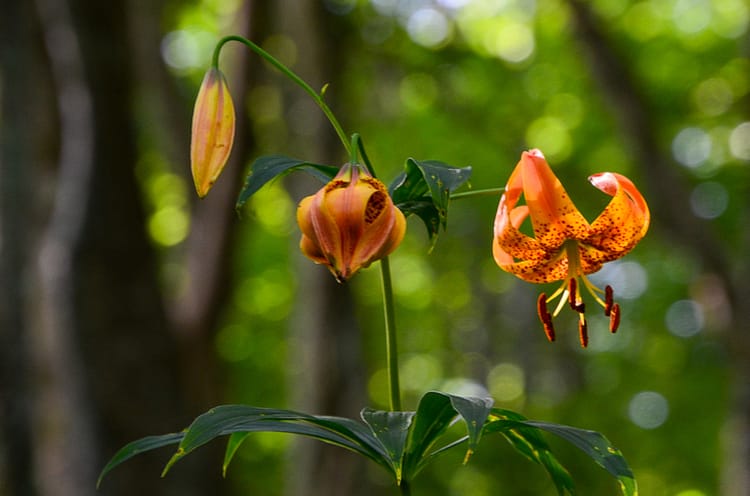To celebrate a steamy Independence Day, we went high in elevation to hike in the Roan Highlands. Our starting point was Hughes Gap, where the Appalachian Trail winds upwards through spruce-fir forest and crosses over Roan Mountain. Our total mileage was 10.2 miles. Our hike began in beauty, with Turk’s cap lilies sprinkled along the trail.

I really love this image; it shows the progression of the Turk’s cap bloom cycle. Initially, the flower is tightly closed; it slowly balloons outward as it unfurls. In full bloom, the flower segments are recurved, proudly displaying the stamens of these wondrous lilies.

Turk’s cap lilies have a green star-shape in the center, which distinguishes them from the Carolina lily. The Turk’s cap are much taller and can have as many as a dozen blooms; the Carolina lily is shorter, only has 2-3 blooms and lacks the green star.

Still and peaceful woods…
The Hughes Gap to Roan Mountain trail meanders uphill the entire way, marked by switchbacks and large rocks. It was so green and lush, with a hushed silence only broken by the sounds of our footsteps and steady breathing.

Bernie pointed out this red spotted newt, which is a temporary coloration in its lifecycle when it dwells on land. The newt wasn’t interested in posing- he was moving away from me as quickly as he could!

Two white moths provided a stark contrast to the varied shades of green surrounding us.

This section of the AT has thousands of Blue Bead Lily, Clintonia borealis, which have pale yellow flowers in early summer. After flowering, Blue Bead lily leaves behind green berries that turn bright blue in late summer and early fall. If you want to see these lilies in full bloom, check out this previous blog entry. https://hikescape.org/mt-mitchell-stands-at-6684-feet-the-highest-peak-in-the-eastern-us-it-is-also-an-area-of-incredible-biodiversity/

Continuing upwards on our hike, I saw the leaves of the wood sorrell, and finally saw their distinctive flowers. This wildflower is another inhabitant of high elevation plant communities. Wood sorrell is easy to identify due to its shamrock-type leaves.



Another beauty is the mountain St. John’s wort, with bright yellow flowers and stamens that reach outward for easy pollination. Its name is Greek, hyper (above) and eikon (a picture). It describes the practice of hanging perennial herbs and shrubs above pictures to ward off evil. Who knew? Thanks to Allen J. Coombes, Dictionary of Plant Names, for this interesting reference. https://www.press.uchicago.edu/ucp/books/author/C/A/au10510272.html

Roan Mountain: 6,286 feet above sea level
Finally, we reached the top, where the Appalachian Trail runs parallel to the Roan Mountain Recreation Area. Nearby is the site of the former Cloudland Hotel, built in 1885. The hotel straddled the North Carolina/Tennessee border, and hotel patrons were only allowed to consume alcohol on the Tennessee side of the establishment. Cloudland was abandoned in the early 1900’s, as the harsh weather took a toll on the structure. https://mitchellnchistory.org/2017/04/02/the-cloudland-hotel-a-mammoth-landmark-of-its-day/
The Cloudland side of the mountain had no views, and it looked like a storm was brewing. We walked over to another lookout from one of the side trails. There are no words to adequately pay homage to these views…



We concluded another memorable day on the Trail, accompanied by a few showers and the intoxicating scent of the spruce-fir forest at Roan Mountain. Between my last post on the Pacific Northwest, and this one, I’ve hiked nearly 50 miles, so it is time to catch up on my blogging.
In the next few posts, I’ll be sharing more orchids and views from the other side of Roan Mountain. The mountains are calling- thanks for sharing our journeys!


